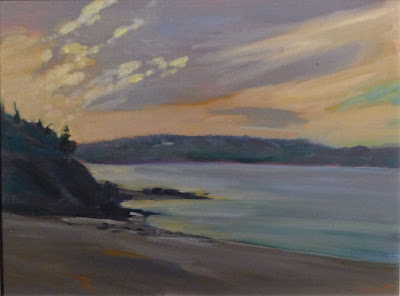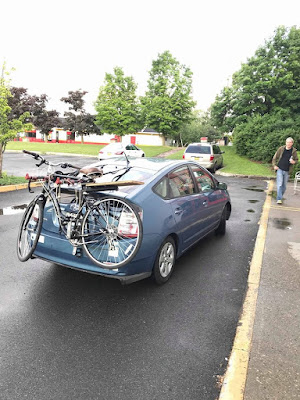Style is a transitory and inconsequential factor, if one can turn it on and off at will.
 |
| Lonely Lighthouse, by Carol L. Douglas |
I haven’t painted in that much rain since a memorable weekend at
Rye’s Painters on Location with
Brad Marshall, where we labored in the tail end of a hurricane. All the best planning won’t save you from low light and rain that blows in sideways under your umbrella. One solution is to paint from your car, but my Prius is too small for one artist, let alone two.
Sometimes, projected rain and fog fails to materialize along the coast. It gets sidetracked by the myriad cliffs, points, headlands and capes. That didn’t happen this weekend. The light was low and flat, and the lovely headlands danced and disappeared into the fog.
Ed Buonvecchio and I were up with first light on Friday to be on our way to Advocate Harbour. A mackerel sky was forming over Cape D’or. That’s a better sign of incipient rain than my arthritis.
 |
| They wrested their living from the sea (Advocate Harbour), by Carol L. Douglas |
This small fishing village by the sea is characteristic of the old North Atlantic coast. We set up in the cemetery. The nearest tombstone to my easel memorialized two members of the same family, lost at sea in 1966. Going to the ocean to work is probably less dangerous today with modern navigation and communication tools, but the North Atlantic is a powerful and fickle mistress.
Later, I chatted for a few minutes with the owner of the herring weir at Partridge Island. He and his crew still tend the nets and harvest the fish with dipping nets. It’s pretty much a lost technology: there are some weirs at Grand Manan and Digby, but most of them are gone. Call me a Luddite if you want, but what value is there in automating work so that some men labor in solitude and others can’t find jobs?
 |
| Cape Blomidon makes its own cloud, by Carol L. Douglas |
By mid-day Friday, we had lost our light.
Poppy Balser, Ed and I trekked out to
Cape D’or and did the “money shot,” but it didn’t move me. There was no sparkle in the water, and no light on the cliffs. I wish I’d painted the rhubarb growing by the lighthouse instead. Neither Poppy nor I submitted our paintings of the cliffs.
The next morning, we tried the overlook at Two Islands. I got a passible painting from it, even though my paint was emulsifying in the blowing rain. Eventually I squelched over to where Ed was set up. “I’m only here because of you,” he told me.
“That’s funny. I’m only here because of you,” I answered. Despite my rain gear, I was soaked down to my step-ins.
We removed to town and the porch of
Ottawa House to finish the day. The volunteers offered us tea and cookies and the opportunity to paint indoors.
This hospitality has been true all over Parrsboro. Canadians are, in general, nice and helpful people. Since their dollar is weak compared to ours, you might think about vacationing there this summer.
 |
| Two Islands in the rain, by Carol L. Douglas |
I’d had my eye on Cape Blomidon for hours, watching a standing hammer-shaped cloud forming off its tip. Volunteer Ed Gilbert told me that this cloud often forms above the cape in bad weather. “Blomiden” is a corruption of Blow-Me-Down, so named because the hot and cold air masses meet there and turn on hapless navigators.
The Quick Draw started in mist and fog, although true rain never really materialized on Sunday. I’d decided to paint with nothing smaller than an #12 round, since it was clear the juror liked that look. That paid off with a second-place ribbon.
We always feel badly if we don’t win prizes at these events, but often the awards have nothing to do with ability or insight and everything to do with style. I like “bold brush” painting as much as the next guy, but it’s not always conducive to describing the world, which is my primary objective. That I could switch it up to win a ribbon is an indication of just how transitory and inconsequential “style” is as a concept.
“I wish I could stay another day,” Ed texted me last night. The sky was clearing, and Cape Blomidon danced in the blue, shimmering light. But Maine is calling us back.






















